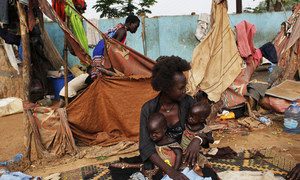Geneva, 29 Mar (Kanaga Raja) – There is a likelihood of further deterioration in acute food insecurity in over 20 countries in the coming months, according to the UN Food and Agriculture Organization (FAO) and the World Food Programme (WFP).In their Hunger Hotspots report covering the period of March-July 2021, FAO/WFP said that the projected rise in acute hunger is due to multiple drivers that are interlinked or mutually reinforcing.
“These are primarily conflict dynamics, economic shocks, the socio-economic impacts of COVID-19, weather extremes and the diffusion of plant pests and animal diseases,” FAO/WFP said.
Of absolute urgent and imminent concern today are more than 34 million people across the world who already face emergency levels of acute food insecurity, it added.
According to the report, a specific group of hotspots – Afghanistan, Burkina Faso, the Central African Republic, the Democratic Republic of the Congo, Ethiopia, Haiti, Honduras, Nigeria, Sudan, South Sudan, the Syrian Arab Republic, Yemen and Zimbabwe – are particularly concerning due to the scale, severity and trends of the existing food crises.
“In some areas of these countries, parts of the population are experiencing a critical hunger situation, with extreme depletion of livelihoods, insufficient food consumption and high acute malnutrition.”
In such fragile contexts, any further shocks could push a significant number of people over the brink and into destitution and even starvation, said the FAO/WFP report.
“The magnitude of suffering is alarming. It is incumbent upon all of us to act now and to act fast to save lives, safeguard livelihoods and prevent the worst situation,” said FAO Director-General Qu Dongyu.
“In many regions, the planting season has just started or is about to start. We must run against the clock and not let this opportunity to protect, stabilize and even possibly increase local food production slip away,” Qu added.
“We are seeing a catastrophe unfold before our very eyes. Famine – driven by conflict, and fuelled by climate shocks and the COVID-19 hunger pandemic – is knocking on the door for millions of families,” WFP Executive Director David Beasley said.
“We urgently need three things to stop millions from dying of starvation: the fighting has to stop, we must be allowed access to vulnerable communities to provide life-saving help, and above all, we need donors to step up with the US$5.5 billion we are asking for this year,” he added.
According to the FAO/WFP report, conflict or other forms of armed violence are likely to increase in parts of Afghanistan, the Central African Republic, the Central Sahel, Ethiopia, northern Nigeria, northern Mozambique, Somalia, South Sudan and Sudan.
“In these contexts, violence will aggravate food insecurity through different pathways – such as new displacements, disruption of trade and cropping, population movements, confinement of communities, abandonment of agricultural land, and loss of life and assets – while also affecting access to humanitarian assistance.”
For instance, in Afghanistan, one of the deadliest conflicts in the world, uncertainty about the withdrawal of foreign military forces, scheduled for May 2021, poses a major risk of further escalation of violence that will drive up displacement, said the report.
The recent conflict in the Tigray region in Ethiopia is likely to have wider repercussions on long-standing fault lines in other parts of the country and might lead to ethnic and inter-communal violence, especially in the run-up to the June elections, it added.
“The crisis engulfing the Central Sahel will continue worsening, with high displacement levels and abandonment of agricultural lands triggered by violent insurgencies and counter-insurgencies.”
In Yemen, conflict is likely to persist on existing front-lines affecting further agricultural and livestock production and trade, while new escalations may happen in some other areas, including the capital.
Meanwhile, in the Syrian Arab Republic, conflict has become static and more localized. For the coming months, it is expected to affect mainly northeastern provinces, said the report.
According to the report, as a result of the economic impact of the COVID-19 pandemic, in 2021, the economies of numerous countries will continue to be highly vulnerable to economic shocks.
FAO/WFP said decreased revenues from remittances, commodity exports, tourism and industrial production have been accompanied by ballooning expenditures aimed at supporting population groups whose incomes have been disrupted by movement restrictions and the near-total shutdown of vital economic sectors such as tourism.
As a result, while several economies are expected to reach pre-crisis levels of output only in 2022, debt levels have been increasing steadily and significantly throughout 2020 and are likely to grow further in 2021.
“In many cases, the debt accumulated over the past year has compounded high pre-existing sovereign and external debt levels, increasing the chance for many countries to default in absence of a strong economic recovery and support by international investors and donors.”
The economic downturn has been particularly pronounced in economies characterized by high levels of informality in the labour market, and especially in countries that were already facing conflict, political and/or socio-economic crisis before the onset of the pandemic, and was therefore lacking crucial buffers to cushion its socio-economic impact, said the report.
FAO/WFP said that as a result of the slow recovery, 2021 is expected to see a continued loss of working hours worldwide in comparison to the last quarter of 2019, estimated at approximately -3 percent (equivalent to 90 million jobs).
In the Middle East and North Africa, countries that were already facing significant conflict and/or socio-economic crises at the end of 2019, such as Yemen, the Syrian Arab Republic and Lebanon, are expected to see further economic deterioration driven by rapid currency depreciation and skyrocketing inflation.
In Latin America, the pandemic was preceded by a protracted period of stagnating growth and increasing debt levels.
As a result, the region has been the most affected worldwide in terms of economic output decline and is expected to see the slowest recovery in the coming years according to the IMF.
Those countries already struggling with political instability, protracted socio-economic issues, climate shocks and high poverty levels, such as Haiti, Venezuela, and the Central American republics of Honduras, El Salvador, Guatemala and Nicaragua, are those poised to show the strongest economic deterioration, said the report.
In addition, in several African countries such as Sudan, Zimbabwe, Sierra Leone and Liberia, elevated levels of currency depreciation and food inflation continue to reduce people’s purchasing power.
FAO/WFP said coupled with recent climatic shocks in some of these countries, which significantly depressed agricultural production, there is a considerable risk that with the likely reduction in domestic food supply, food inflation may worsen in the coming months.
The report noted that weather and climate extremes driven by the ongoing La Nina event, expected to continue through April/May 2021, are likely to affect several parts of the world.
In Afghanistan, poor rainfall has affected most parts of the country since November 2020 and continues to be forecast, threatening rain-fed wheat-crop production.
Water availability for spring and summer crops could also be limited due to reduced snow-melt in some basins.
In South Sudan, above-average rainfall is expected, with an increased likelihood for flooding in some areas, said the report.
In Haiti, poor previous harvests, due to climate shocks and Hurricane Laura, could be further aggravated by potential below-average rainfall for the upcoming first rainy season from April to June.
In Central America, the double impact of hurricanes Eta and Iota in the fourth quarter of 2020 have significantly affected vulnerable livelihoods.
The desert locust situation in East Africa and on the Red Sea Coast remains of concern and should be monitored closely in the coming months, said FAO/WFP.
In Southern Africa, more specifically in parts of Angola, Botswana, Namibia, Zambia and Zimbabwe, a serious outbreak of the African migratory locust poses a serious threat to summer cropping, it added.
Overall, humanitarian access constraints continue to be a prominent aggravating factor for acute food insecurity, hampering crisis-affected populations’ access to much-needed humanitarian assistance, said the report.
It noted that as of December 2020, access continues to be extremely challenging in Yemen, as a result of conflict and insecurity, bureaucratic impediments, and COVID-19 restrictions.
Constraints remain very high in parts of Afghanistan, the Democratic Republic of the Congo, Ethiopia, Mali, Nigeria, Somalia, South Sudan and Venezuela, while Burkina Faso, the Central African Republic, Honduras, Lebanon, Mozambique, the Niger and Sudan are experiencing high constraints.
Yemen, South Sudan and Nigeria remain countries with the highest alert for the outlook period, said the report.
Among the hotspot countries, Afghanistan, the Democratic Republic of the Congo, Ethiopia, Haiti, Sudan and the Syrian Arab Republic are of absolute urgent and imminent concern, as they have large numbers of people or prevalence of people in an emergency (IPC Phase 4).
“Further intensification of conflict, deepening economic crises and weather extremes, combined with varied restrictions to humanitarian access, are likely to further aggravate critical food insecurity levels in the next six months,” the FAO/WFP report cautioned. – Third World Network
Published in SUNS #9316 dated 30 march 2021




